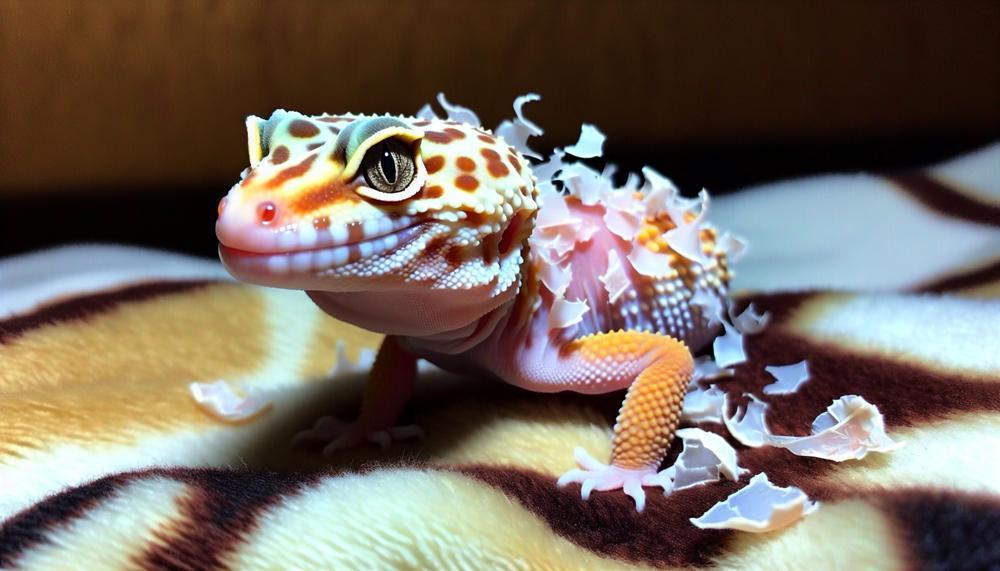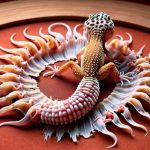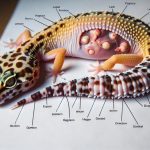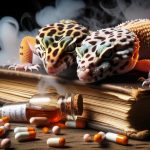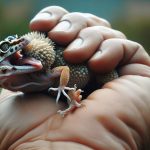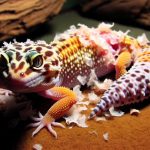Have you ever observed that your leopard gecko is not quite ready to lose its skin, but it does seem a little off-color and pale? Many pet owners may find themselves perplexed by this appearance and unsure whether their pet needs to see the veterinarian soon. But before you get too worked up, let’s examine a few of the causes of this strange occurrence.
The purpose of this blog article is to explain why your leopard gecko may seem paler than normal without exhibiting the typical symptoms of shedding.
So, Why Is My Leopard Gecko Pale But Not Shedding?
A leopard gecko that is pale but not shedding could be experiencing dehydration or another issue. Other reasons include: poor diet, low humidity levels, and full grown.
Here are some signs that a leopard gecko is about to shed: Turns pale, Hides in a moist hide and doesn’t walk around much, Doesn’t want to be handled, Stops eating, and Rubs face against things to loosen skin.
Most leopard geckos shed every four to eight weeks, and they often eat their shed skin to regain nutrients. Before shedding, they turn a whitish-gray color. Unlike snakes, geckos shed skin in pieces, and often keep unshed skin over their eyes and toes.
So, let’s get started.
Contents
Possible Reasons Your Leopard Gecko Is Not shedding
When your leopard gecko isn’t shedding properly, it’s time to play detective and pinpoint the potential causes.
| Cause | Details | Solutions |
| Inadequate Humidity | Geckos thrive in 20%-30% humidity. Low levels lead to flaky, tough-to-remove skin. | Install a hygrometer, mist their habitat, and ensure their moist hide is, well, moist. |
| Lacking Moist Hide | A snug, humid refuge is vital during shedding. Missing this can mean patchy sheds. | Set up a moist hide lined with damp paper towels or moss in the warm part of their home. |
| Nutritional Deficiencies | Skimping on essential nutrients, like calcium and vitamin D3, results in poor skin health. | Feed a balanced diet supplemented with the right vitamins and minerals. |
| Stress | Anxious geckos face shedding woes. Changes in environment or mishandling could be the stressors. | Minimise disturbances and handle them gently, if necessary. |
| Skin Infections | Infections make shedding a pain, marked by redness, swelling, or bad odours. | Spot the signs? Time for a vet visit. |
| Old Age | Time makes skin less flexible and shedding more cumbersome. | Assist gently with damp cotton swabs but avoid peeling skin forcibly. |
A well-set-up enclosure and balanced diet go a long way in preventing these issues. Keep a keen eye on your gecko’s skin and behaviour, especially around shedding time.
Shed delay and health problems in Leos
Shed delay in leopard geckos, affectionately known as Leos, can be more than just a hiccup in their care routine; it can signal underlying health issues that require swift action.
| Health Issue | Cause | Potential Treatment |
| Skin Infections/Irritations | Remaining shed skin | Improved humidity, veterinary topical treatment |
| Impaction | Indigestible substrate/food items | Dietary adjustments, possible veterinary intervention |
| Stress | Shedding difficulty | Environmental adjustments, reducing handling |
| Metabolic Bone Disease | Calcium deficiency | Supplementation, UVB lighting |
| Parasites | External/internal infestations | Antiparasitic medication, veterinary care |
Ensuring your Leo has the right environment and diet is paramount in preventing these issues.
Can terrarium conditions affect the shed?
Terrarium conditions, notably temperature and humidity, play a pivotal role in the shedding process of leopard geckos. Shedding is a natural and essential aspect of their life cycle, necessary for growth and health. Incorrect terrarium conditions can cause problematic sheds, which could indicate underlying health issues.
Impact of Temperature:
| Condition | Effect on Shedding |
| Optimal (75-85°F day, 65-75°F night) | Facilitates normal shedding |
| Too Low | Can slow down the shedding process |
| Too High | May cause dehydration, affecting skin elasticity |
Impact of Humidity:
| Condition | Effect on Shedding |
| Optimal (30-40%) | Supports complete and healthy shedding |
| Too Low | May lead to incomplete shedding, skin sticking |
| Too High | Could cause respiratory problems, skin infections |
Creating a microclimate in their terrarium that mimics their natural, arid habitat is essential. This can be achieved through an undertank heater or basking bulb for warmth, and regular misting or a reptile fogger to maintain humidity. Monitoring these conditions with a digital thermometer and hygrometer is key to ensuring a healthy shed.
A leopard gecko struggling to shed due to poor terrarium conditions can suffer from stress and potential skin infections. In severe cases, constricted skin can even lead to loss of extremities.
Can Diet Stop a Leopard Gecko Shedding?
No, diet cannot stop a Leopard Gecko from shedding as it is a natural and necessary process for their growth and health.
However, their diet can significantly influence the ease and efficiency of the shedding process.
Nutrition’s Role in Shedding: A Closer Look
Leopard Geckos, enchanting little creatures with their vibrant colours and docile nature, undergo periodic shedding as part of their growth cycle. This shedding, while inevitable, can be smooth or troublesome based on several care aspects, diet being a pivotal one. Here’s how a well-rounded diet plays its part:
- Hydration: Paramount for a hassle-free shed, hydration can be directly affected by diet. Foods with higher moisture content can aid in keeping the gecko well-hydrated, thus facilitating easier shedding.
- Nutritional Balance: Essential nutrients like vitamins and minerals (particularly Vitamin A and calcium) play a crucial role in skin health, potentially reducing the incidence of shedding-related complications.
Table: Dietary Components and Their Impact on Shedding
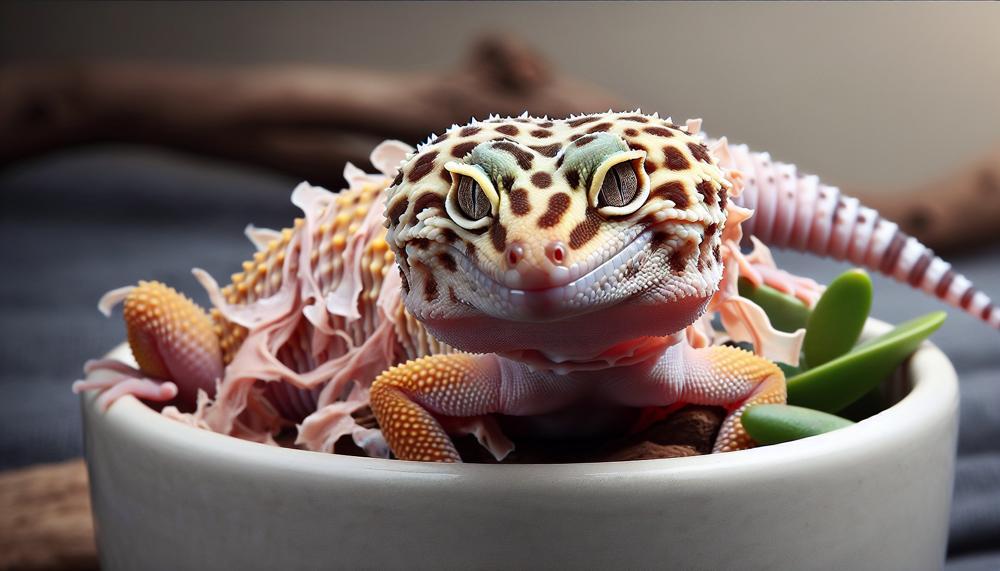
| Component | Benefits | Sources |
| Water | Ensures hydration, aiding in skin elasticity and ease of shed. | Water bowls, moist foods like fruits (in moderation). |
| Vitamin A | Supports skin health and regeneration. | Carrots, sweet potatoes, leafy greens (provided sparingly). |
| Calcium | Essential for overall health and prevention of metabolic bone disease, indirectly supporting the shedding process. | Calcium supplements, gut-loaded insects. |
Practical Tips for Supporting Shedding Through Diet:
- Hydration is key: Ensure your gecko has access to fresh water daily. Consider incorporating foods with high water content to supplement hydration.
- Balance is vital: A diet rich in variety will supply all necessary nutrients. Gut-loading feeder insects with nutritious foods can pass those benefits on to your gecko.
- Supplementation: Calcium and vitamin supplements may be necessary, especially for geckos not exposed to natural sunlight or UVB lighting.
In the tapestry of care for Leopard Geckos, diet emerges not as a stopper of shedding but as a supporter of this natural process.
Ovulation and Brumation
Leopard geckos are fascinating creatures, with behaviours deeply rooted in their natural cycles, particularly when it comes to ovulation and brumation.
These periods significantly influence their physical activities, including the shedding process.
Brumation: A Time of Rest
Brumation, akin to hibernation in mammals, is a period when leopard geckos slow down to conserve energy in colder months. During this phase, they might cease eating and become less active, which impacts how they shed.
Since shedding is tied to growth and physical activity, a gecko in brumation might shed less frequently or have delayed shedding due to their decreased metabolism and activity levels.
Ovulation: A Season of Change
Ovulation is another critical period, particularly for female geckos. During ovulation, their bodies are preparing for potential reproduction, which can alter their normal processes, including shedding.
Hormonal changes can either accelerate or delay shedding as the body’s focus shifts towards reproduction.
Conclusion
Your leopard gecko is gently alerting you to take a closer look at their care and living circumstances when it becomes pale without the obvious symptoms of shedding.
The reasons for this unusual paleness might be many and varied, ranging from the faint echoes of disease or nutritional demands to the whispering of stress and environmental inconsistencies.
The atmosphere of the enclosure, with its warmth, humidity, and tranquility, is the unsung hero that creates the conditions for a successful shed or a miserable situation.
To solve this mystery, you need a kind hand and an acute eye. Think of the terrarium as a microcosm of their natural environment rather than as a cage, where every variation in humidity and temperature may contribute to their overall health. Nutrition is more than just food; it’s the foundation of robust health, adding colorful colors to your gecko’s life.
If this faint mystery continues, consulting a veterinarian’s expertise may illuminate hidden details. It’s not only about curing symptoms; it’s also about creating an atmosphere in which your leopard gecko may thrive, shedding skin and whatever pain it may be feeling to expose the colorful animal within.
Your finest assets in the world of reptile care are patience, observation, and a healthy dose of curiosity. Establish a haven, provide a food high in the essential elements of life, and make sure that their little area of the world is peaceful.

